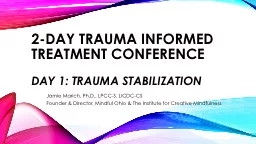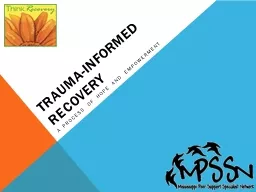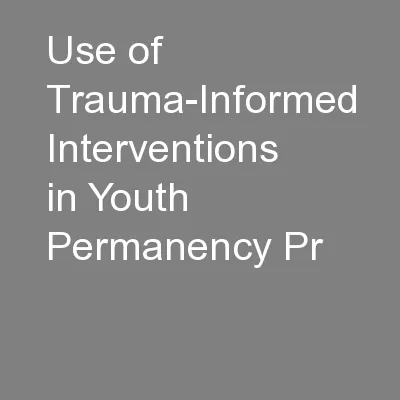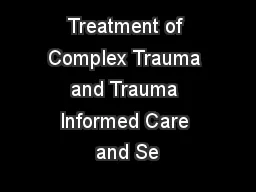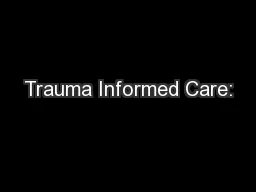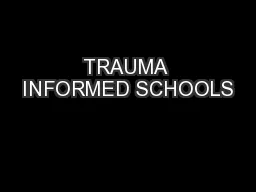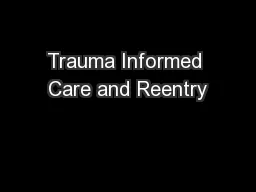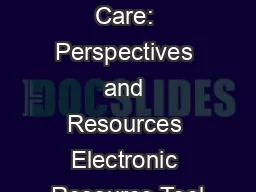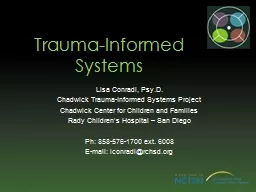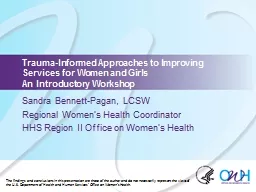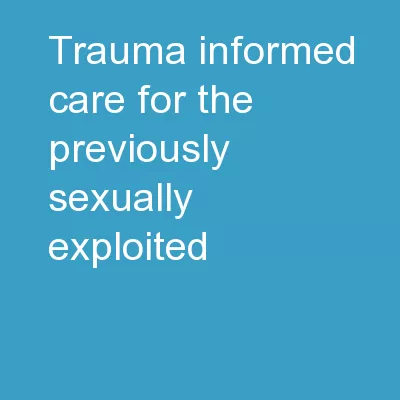PPT-2-Day Trauma Informed Treatment
Author : cheryl-pisano | Published Date : 2017-06-27
Conference Day 1 Trauma Stabilization Jamie Marich PhD LPCCS LICDCCS Founder amp Director Mindful Ohio amp The Institute for Creative Mindfulness About Your Presenter
Presentation Embed Code
Download Presentation
Download Presentation The PPT/PDF document "2-Day Trauma Informed Treatment" is the property of its rightful owner. Permission is granted to download and print the materials on this website for personal, non-commercial use only, and to display it on your personal computer provided you do not modify the materials and that you retain all copyright notices contained in the materials. By downloading content from our website, you accept the terms of this agreement.
2-Day Trauma Informed Treatment: Transcript
Conference Day 1 Trauma Stabilization Jamie Marich PhD LPCCS LICDCCS Founder amp Director Mindful Ohio amp The Institute for Creative Mindfulness About Your Presenter Licensed Supervising Professional Clinical Counselor . Mandy A. Davis, LCSW. madavis@pdx.edu. 503-725-9636. Agenda - Welcoming. Mandy Davis, LCSW. Trauma Informed Care Project & Trauma Informed Oregon . Consult & Train with CW, SS, Schools, County Teams, Judges, Lawyers, Health Care, Housing. A process of hope and empowerment. What is Trauma-Informed Recovery?. Most individuals seeking mental health . services have . histories of physical and sexual abuse and other types of trauma-inducing experiences.. Erika Tullberg, MPA, MPH. Assistant Research Professor. NYU Child Study Center. November 27, 2012. Workshop Overview. What does trauma look like in older youth?. What challenges does trauma present in permanency planning?. Perinatal Mental Health Seminar. Dr.. Cathy Kezelman. ©ASCA 2014 . . ©ASCA 2014 . “Failure to acknowledge the reality of trauma and abuse in the lives of children, and the long-term impact this can have in the lives of adults, is one of the most significant clinical and moral deficits of current mental health approaches. . Proposal for statewide implementation. 1. John R. Kasich. , . Governor. Tracy J. Plouck. , . Director. John . L. Martin. , . DODD Director. Ohio’s Trauma Informed (. TIC) . Care Initiative. Vision:. A Book In Progress. WASSW. FALL CONFERENCE. Corrine Anderson-Ketchmark, MSW. Presenter. Trauma Informed Schools (TIS). This presentation will cover:. A Systems Change focus to Build Adult Capacity for Improving Student Learning using Trauma Informed practices. David A Washington, MSW . Washington County Health Department. Division of Behavioral Health Services. Program Coordinator . Jail Substance Abuse Program & . Trauma, Addictions, Mental Health And Recovery (TAMAR) Program. Pediatric/Children’s Disaster Resilience Group Call - March 12, 2015. Presenter. Eileen Elias, MEd. Senior Policy Advisor for Disability and Mental Health. Director, Disability Services Center. JBS International. Conradi. , . Psy.D. .. Chadwick Trauma-Informed Systems Project. Chadwick Center for Children and Families. Rady. Children’s Hospital – San Diego. Ph. : 858-576-1700 ext. 6008. E-mail: lconradi@rchsd.org. An Introductory Workshop. . Sandra Bennett-Pagan, LCSW. Regional Women’s Health Coordinator. HHS Region II Office on Women’s Health. The findings and conclusions in this presentation are those of the author and do not necessarily represent the views of the U.S. Department of Health and Human Services’ Office on Women’s Health.. Ukpong Etteh. Project Preceptor: Dr. Jennifer Bradford MD, MPH. University of Massachusetts Medical School. The Problem. In Worcester, women involved in sex trafficking are overwhelmingly burdened with substance use disorder, mental illness, homelessness and recidivism. Many of the survivors are unable to become fully self-sufficient due to their Criminal Offender Record Information (CORI), which limits their ability to obtain jobs, financial aid, and housing.. Dr. Sonalika’s Eye Clinic provide the best Ocular trauma treatment in Pune, Hadapsar, Amanora, Magarpatta, Mundhwa, Kharadi Rd, Viman Nagar, Wagholi, and Wadgaon Sheri Dr. Sonalika’s Eye Clinic provide the best Eye infection treatment, Conjunctivitis treatment in pune, Hadapsar, Amanora, Magarpatta, Mundhwa, Kharadi Rd, Viman Nagar, Wagholi, and Wadgaon Sheri Dr. Sonalika’s Eye Clinic provide the best Conjunctivitis (Pink Eye) treatment in Pune, Hadapsar, Amanora, Magarpatta, Mundhwa, Kharadi Rd, Viman Nagar, Wagholi, and Wadgaon Sheri
Download Document
Here is the link to download the presentation.
"2-Day Trauma Informed Treatment"The content belongs to its owner. You may download and print it for personal use, without modification, and keep all copyright notices. By downloading, you agree to these terms.
Related Documents

